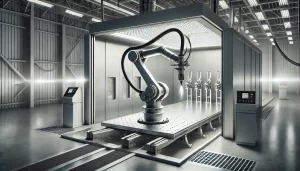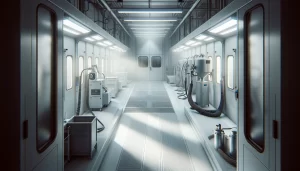When it comes to choosing the right paint booth for your business, understanding the differences between open-face, downdraft, and crossdraft designs is crucial. Each type has its own advantages, depending on the kind of work you do, the finish quality you need, and the space available in your facility. While all three serve the purpose of containing overspray and controlling airflow for better paint application, they operate differently and offer distinct benefits.
Open-Face Paint Booths: Simple and Cost-Effective
Open-face paint booths are among the most commonly used designs, especially in industries where smaller parts or batch jobs are painted. As the name suggests, these booths have an open front, allowing easy access for operators to move parts in and out. They typically feature a filtered exhaust system at the rear, pulling air through the open front and directing it towards the back of the booth.
One of the main reasons businesses opt for open-face booths is their affordability. Compared to enclosed models, they require less material to construct and have a simpler ventilation system, reducing costs. They are also easier to install and take up less space, making them a great option for workshops that don’t have a dedicated area for painting.
However, because of their open design, they are more prone to contamination from dust and debris in the surrounding workspace. Airflow control is also less precise than in fully enclosed models, which can impact finish quality, especially for high-end automotive or industrial coatings. That said, for applications like wood finishing, furniture painting, or coating smaller parts, open-face booths offer an efficient and practical solution.
Crossdraft Paint Booths: Efficient and Space-Saving
Crossdraft paint booths are one of the most widely used enclosed designs. These booths pull air from one end of the booth and direct it horizontally across the workpiece before exhausting it at the opposite end. Unlike open-face booths, crossdraft designs are fully enclosed, which helps in maintaining a cleaner environment for painting.
A major advantage of crossdraft booths is their efficient use of space. They don’t require a pit or underground exhaust system like downdraft booths do, making installation easier and more cost-effective. The airflow pattern ensures a steady stream of fresh air moves across the surface of the object being painted, which helps in carrying away overspray and contaminants.
However, because air moves horizontally across the workpiece, there’s a higher chance of overspray landing on freshly painted surfaces. This can sometimes affect finish quality, particularly on large, flat surfaces like car hoods or industrial panels. Skilled painters can adjust their technique to compensate for this, but for those requiring the highest-quality finishes, additional filtration or airflow adjustments may be needed.
Downdraft Paint Booths: Premium Finish with Maximum Containment
Downdraft paint booths offer the highest level of finish quality and contamination control. These booths pull air from the ceiling and direct it straight downward before exhausting it through vents in the floor. This design ensures that overspray and dust are immediately pulled away from the painted surface, reducing the risk of defects and providing a cleaner, smoother finish.
One of the biggest benefits of downdraft booths is their ability to evenly distribute airflow around the entire workpiece. This is especially important for industries where flawless finishes are required, such as automotive refinishing, aerospace coatings, and high-end manufacturing. The downward airflow minimizes turbulence, helping paint settle smoothly and evenly.
However, this level of quality comes with a higher price tag. Downdraft booths require an exhaust pit or basement-level ducting to handle the airflow properly, making installation more complex and costly. They also take up more space, which can be a limiting factor for smaller shops. Despite these challenges, businesses that prioritize finish quality and efficiency often find the investment in a downdraft booth worthwhile.
Choosing the Right Booth for Your Needs
The decision between an open-face, crossdraft, or downdraft paint booth depends on several factors, including budget, available space, and the type of work you do. If affordability and accessibility are top priorities, an open-face booth is a solid choice. For a balance between efficiency and quality, a crossdraft booth can offer great performance without requiring major structural modifications. If achieving a showroom-quality finish is your primary goal, a downdraft booth will provide the best results.
Understanding these differences will help you make an informed decision that aligns with your business needs. No matter which type of booth you choose, ensuring proper airflow, filtration, and maintenance will help you get the most out of your investment while delivering high-quality painted products.
How We Can Help with Your Paint Booth Needs
At Paint Booth, we specialize in providing top-tier paint booths and finishing equipment tailored to your business requirements. Whether you need a standard-size paint booth or a custom solution designed for your unique projects, our expert team is here to assist you every step of the way. From design to installation, we ensure that your equipment meets the highest industry standards, enhancing both your productivity and the quality of your finishes. Contact us today to find the perfect paint booth solution for your business!




